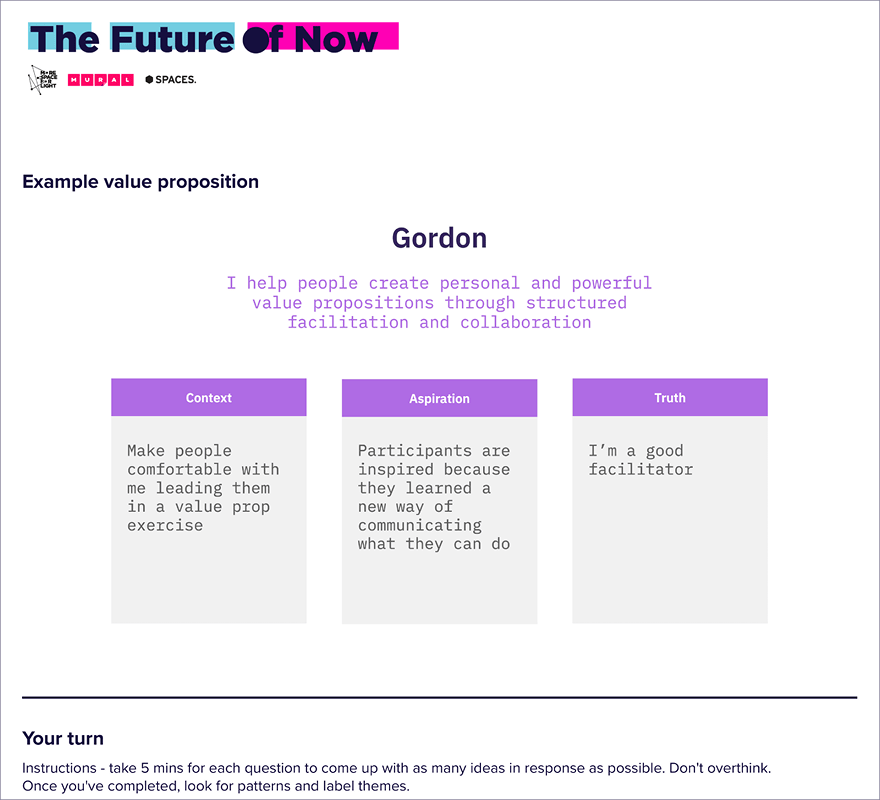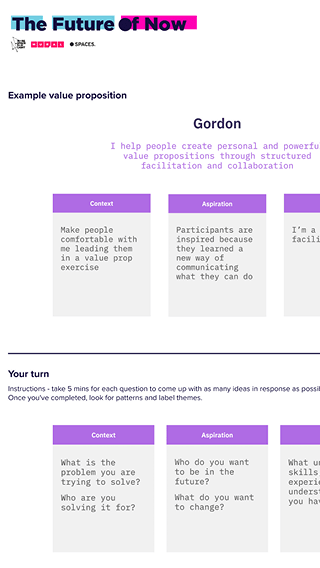
The following excerpt is transcribed from the Zoom event that took place on 16 July 2020.
Key points
- A good value proposition should push you out of your comfort zone, while clearly articulating your skills, expertise and ability to help the team overcome challenges.
- The role of a Designer positions us to think about the future we’re projecting ourselves into.
- To be successful in translating design to strategy we need to consider how things connect, are inclusive, and are sustainable.
Speaker
Gordon is an award-winning Designer and currently the Experience Design Director at management consultancy McKinsey & Company. In his role, Gordon leads by bringing design strategy and the creation of enterprise solutions to clients across Asia. Gordon is also a lecturer on the topics of Design Thinking for Innovation and Interaction Design, as well as a mentor to startups in Southeast Asia where he’s based.
Why being a stranger can be a good thing
Being a stranger does not have to have negative connotations. As illustrated by the following metaphors, being a stranger in various ways can help to build up a new set of skills to move from interaction to strategy —
The Explorer — curious, a problem-solver, being comfortable with the unknown
Being a stranger in the truest sense, such as being in new countries and/or environment means that you are in a position where you learn to not only survive but also thrive. You have the luxury of approaching obstacles with curiosity and a ‘beginners mind’. This requires being comfortable with the unknown because while navigating these new places, you also need to figure out how to get things done; from learning the language to finding a job, to finding a new home. The unknown can also lie in communication, which is more than just about language and stems into areas that can be harder to understand and learn, such as cultural differences and unspoken exchanges.
The Exchange Student — adaptability, being mindful of the importance of culture, customs, rituals, and communication
The key components of being an Exchange Student is adaptability and applying that understanding of the importance of culture, customs and rituals so that you can communicate in an effective and respectful way. Every home, organisation, institution etc. have their own culture, which means that while there is an exchange that occurs (i.e.the application of your skills for a new experience), every interaction has to be done in a way that is connected to the structure of the organisation.
The Time Traveller — the power of imagination, understanding relationships, creating structure
As Designers we have to position ourselves as part of the future we’re projecting ourselves into. We are not only trying to understand that space but also trying to work backwards to understand how we can realise this and bring people along the journey.
Why we need to move from interaction to strategy
In order to design the world and the things in the world that are inclusive, sustainable and connective we need to be armed with the types of skills that are going to help us move into a strategic space. This is important because this is the space where the decisions are being made that affect all experiences and interactions. This is where leveraging the skills accrued from being a stranger and/or adopting a ‘beginners mind’ can add value in creating experiences for other people. Meaningful conversations also need to occur, so that nothing is lost in translation during the process and that you don’t design in a vacuum.
How to have meaningful conversations and create powerful value propositions
Referring to the Exchange Student metaphor, for Designers, this means translating design into a language that others will be able to comprehend and communicate in. This will help people to understand the value of design to utilise its impact. While ensuring the value of design is equal to all conversations being held in the strategic space.
As your experiences come together, it is also important to communicate your value proposition in a way that people will understand. A good value proposition should push you out of your comfort zone, while clearly articulating your skills, expertise and ability to help the team overcome challenges. To craft a great value proposition, it should encompass the following:
- Context – what is the problem you are trying to solve? Who are you solving for?
- Aspiration – who do you want to be in the future? What do you want to change?
- Truth – what unique skills, experiences or understandings do you have?
Q&A
How is innovation measurable and how do we evaluate its success and impact?
GC – I find that many people always default to some kind of monetary value, eg. how much money will you be saving/making as a result of said initiative? We are often pushing for different measures of impact, eg. things like safety or time-saving efficiencies. There are still a lot of organisations that don’t necessarily look at alternative ways of measuring impact or what impact actually means. It’s a conversation that we’re continuously having, and I don’t think we’ve solved it yet.
DL – What we’ve found at More Space is that many organisations have an appetite to change the mindset from old ways of working and thinking that are deeply entrenched in the culture of the organisation. This may not necessarily result in tangible short-term tangibles. We’re helping build this change by co-creating environments that give people permission to ‘embrace’ failure and not regard it as a bad thing, removing the fear factor associated. We’ve been told by leaders that their team is naturally taking a step back to apply our methods to independently abstract challenges, and as a result, coming up with new solutions. These solutions might not necessarily relate to something that goes out into the world. But they lead to a more inclusive, collaborative and innovative approach to problem-solving.
We’ve arrived at this purely by accident as our intention is to help people adopt a more human-centred approach to problem-solving. This has proved a big win and a point of differentiation for us going into organisations.
What differences do you perceive in the mindsets between different countries?
GC – I’ll keep it contextual to work. I’ve been living in Southeast Asia for a while and I definitely think that there’s a different understanding in terms of design acceptance and maturity of what design is, what it can do, etc. The way this plays out is that the speed and acceleration of innovation and transformation are extremely fast, especially in places like Thailand, and Singapore and China. A lot of that is built on the ‘Startup Approach’, eg. we find a problem, we improve it, we fix it, we drive it further.
In terms of government support, for example, in the UK, there’s a lot of support and a lot of education about design, which we don’t necessarily have here in Thailand. I used to work at the university teaching design to students, so we’re trying to help bring that capability here. However, we’re a long way off, to be honest.
Further reading
- Dark Matter & Trojan Horses, by Dan Hill
- Mismatch: How Inclusion Shapes Design, by Kat Holmes
- Upstream: The Quest to Solve Problems Before They Happen, by Dan Heath
To see all our speaker Future Of Now book recommendations click here.
More about Gordon Candelin and connect
- Connect on LinkedIn
- On Twitter @MetaHeavies
- McKinsey & Company
About The Future Of Now series
Our goal at More Space For Light with The Future of Now (FON) series is to build a community of like-minded passionate professionals. We intend to bring together like-minded professionals to share, inspire, and explore new opportunities for growth. So you can discover new ways of working to bring back into your organisation.
More about the organisations connected to this event
- morespaceforlight.com.au – A strategy and innovation consultancy specialising in both in-person and/or remote workshops, design programs and Design Sprints.
- MURAL.CO – a remote collaboration whiteboard. With this platform you will supercharge your remote and in-person meetings and workshops.
- hacker.exchange – a global education company that is supercharging the next generation of startups & leaders.


